前言:上一篇結束了堆疊的實作,今天要來介紹新東西「佇列」。
佇列的特性:佇列和堆疊非常類似,同樣都是有序串列(元素以某種順序排列 ,該順序具有一定的意義,不可錯置),且同樣屬於抽象資料型態。
佇列與堆疊的差別在於佇列為「先進先出(FIFO,First In First Out)」,就好比先排隊的人先買到門票一樣。
圖片來源:http://runningmanmacau.weebly.com/uploads/2/7/2/0/27203993/s416834513424666157_p2_i1_w640.jpeg
如果以電腦的角度來看,堆疊的新增和刪除只能發生在頭節點,而佇列多了一個後端指標負責新增資料,前端指標用來讀取和刪除。
環狀佇列:佇列的實際應用之一,經常用於行車紀錄器或監視器之類的裝置,儲存特定天數的資料,若天數已滿則將第一天從前端刪除,並從末端加入新的一天。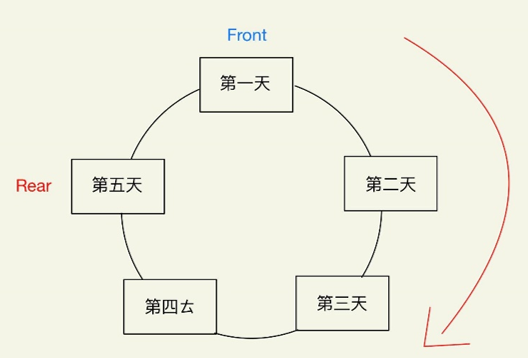
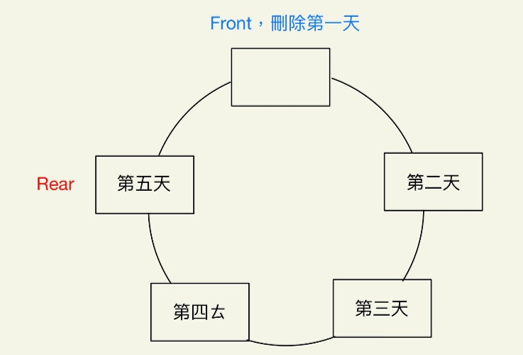
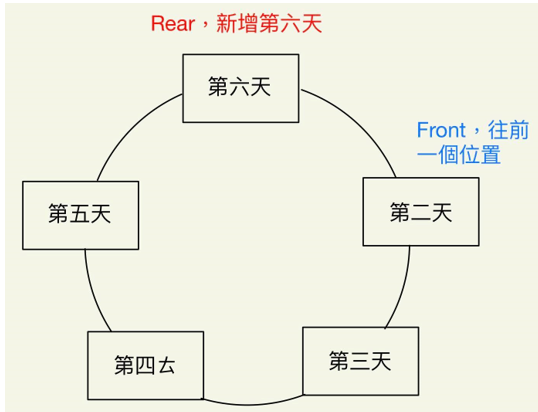
依照這樣的做法就能成功創建了喔!
接著就實際操作看看,一樣要先創建新的專案୧| ” •̀ ل͜ •́ ” |୨
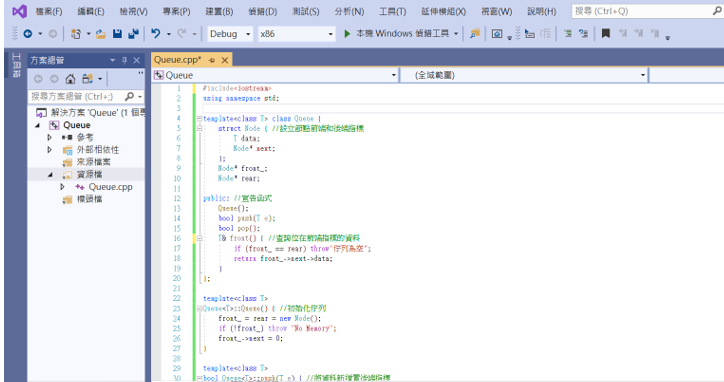
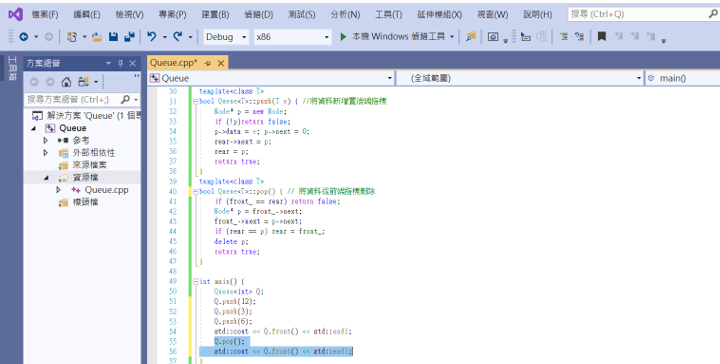
std::cout << Q.front() << std::endl;為顯示佇列前端指標的資料,所以可以看到12位在佇列最前端,將其pop之後最前端的位置就變為3。
也可持續pop直到佇列為空的,首先要判斷佇列是否沒有資料。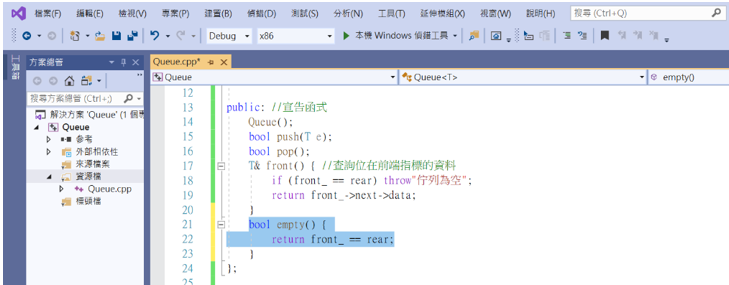
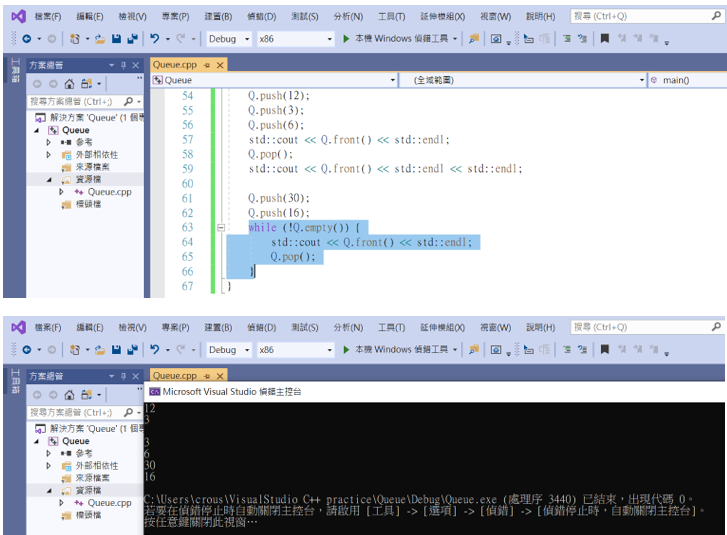
這樣就完成最初始的佇列了喔,緊接著就來挑戰進階一些的環狀佇列。
直接在資源檔中新增項目即可,不需要創建新的專案。但同樣一個專案不能有兩個main程式,如果不知道怎麼操作的,可以看看上一篇文章
之後就可以開始實作了。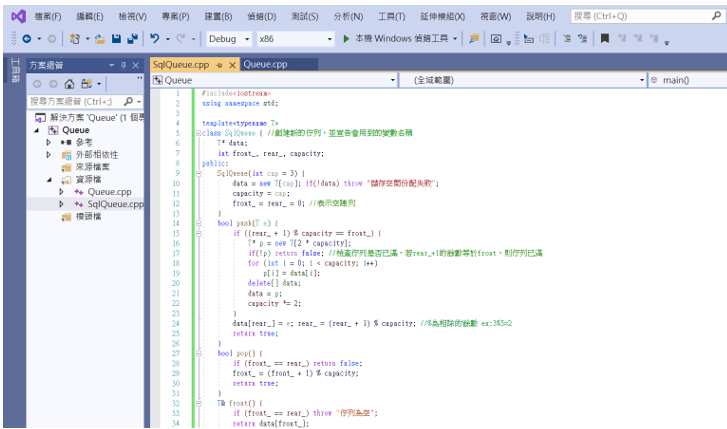
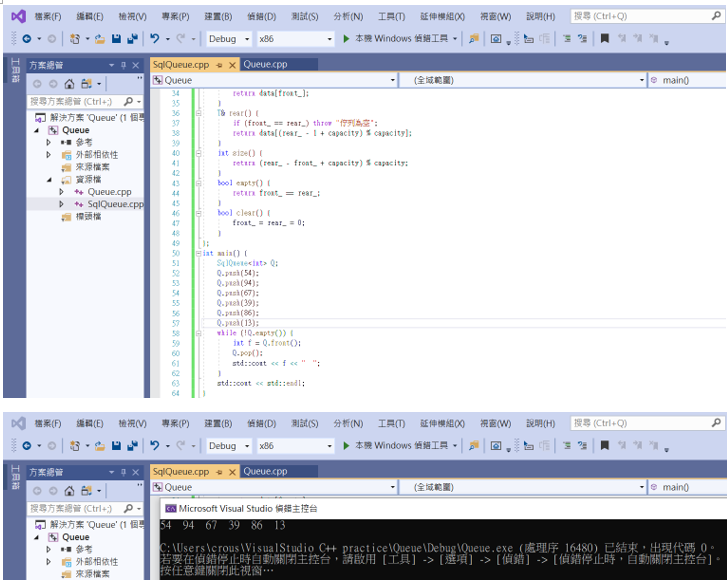
因為是環狀佇列,所以也可以從末端查詢資料。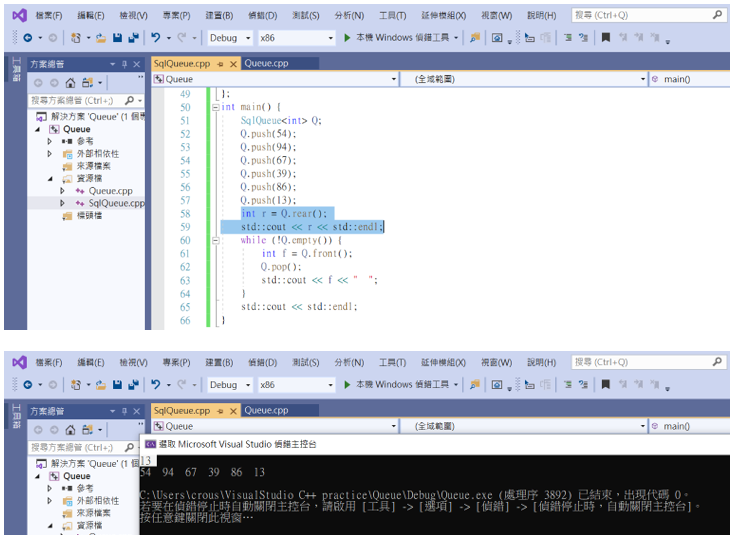
這樣就完成了喔!
本日小結:今天做完了佇列和循環佇列,循環佇列和佇列的概念非常類似,但是如果要對循環佇列進行新增和刪除的話,都必須要用除以容量的餘數去考慮,這個部分比較複雜,需要花時間理解,佇列還有一些東西沒講到,會在之後的文章說明,明天將要進入資料結構中最重要的一環「樹」的部分१|˚–˚|५
佇列
#include<iostream>
using namespace std;
template<class T> class Queue {
struct Node { //設立節點前端和後端指標
T data;
Node* next;
};
Node* front_;
Node* rear;
public: //宣告函式
Queue();
bool push(T e);
bool pop();
T& front() { //查詢位在前端指標的資料
if (front_ == rear) throw"佇列為空";
return front_->next->data;
}
bool empty() {
return front_ == rear;
}
};
template<class T>
Queue<T>::Queue() { //初始化佇列
front_ = rear = new Node();
if (!front_) throw "No Memory";
front_->next = 0;
}
template<class T>
bool Queue<T>::push(T e) { //將資料新增置後端指標
Node* p = new Node;
if (!p)return false;
p->data = e; p->next = 0;
rear->next = p;
rear = p;
return true;
}
template<class T>
bool Queue<T>::pop() { // 將資料從前端指標刪除
if (front_ == rear) return false;
Node* p = front_->next;
front_->next = p->next;
if (rear == p) rear = front_;
delete p;
return true;
}
int main() {
Queue<int> Q;
Q.push(12);
Q.push(3);
Q.push(6);
std::cout << Q.front() << std::endl;
Q.pop();
std::cout << Q.front() << std::endl << std::endl;
Q.push(30);
Q.push(16);
while (!Q.empty()) {
std::cout << Q.front() << std::endl;
Q.pop();
}
}
環狀佇列
#include<iostream>
using namespace std;
template<typename T>
class SqlQueue { //創建新的佇列,並宣告會用到的變數名稱
T* data;
int front_, rear_, capacity;
public:
SqlQueue(int cap = 3) {
data = new T[cap]; if(!data) throw "儲存空間份配失敗";
capacity = cap;
front_ = rear_ = 0; //表示空陣列
}
bool push(T e) {
if ((rear_ + 1) % capacity == front_) {
T* p = new T[2 * capacity];
if(!p) return false; //檢查佇列是否已滿,若rear_+1的餘數等於front,則佇列已滿
for (int i = 0; i < capacity; i++)
p[i] = data[i];
delete[] data;
data = p;
capacity *= 2;
}
data[rear_] = e; rear_ = (rear_ + 1) % capacity; //%為相除的餘數 ex:3%5=2
return true;
}
bool pop() {
if (front_ == rear_) return false;
front_ = (front_ + 1) % capacity;
return true;
}
T& front() {
if (front_ == rear_) throw "佇列為空";
return data[front_];
}
T& rear() {
if (front_ == rear_) throw "佇列為空";
return data[(rear_ - 1 + capacity) % capacity];
}
int size() {
return (rear_ - front_ + capacity) % capacity;
}
bool empty() {
return front_ == rear_;
}
bool clear() {
front_ = rear_ = 0;
}
};
int main() {
SqlQueue<int> Q;
Q.push(54);
Q.push(94);
Q.push(67);
Q.push(39);
Q.push(86);
Q.push(13);
int r = Q.rear();
std::cout << r << std::endl;
while (!Q.empty()) {
int f = Q.front();
Q.pop();
std::cout << f << " ";
}
std::cout << std::endl;
}
